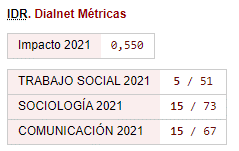Límites visuales entre normatividad y diversidad
Palabras clave:
Estudios de género y sexualidad, cineResumen
En las últimas décadas han ido emergiendo estudios específicamente cinematográficos sobre representaciones de transiciones y redefiniciones de género a través del vestido, la reconstitución corporal y posturas discordantes frente a las normas imperantes. Este artículo se propone recorrer sus principales aportaciones –y las de sus referentes en las artes escénicas- con un doble objetivo. Por un lado, trazar un marco teórico con las relecturas fílmicas de terminologías, mecanismos narrativos y modelos discursivos de la tradición cultural, testimonial y activista. Por otro, señalar la polisemia de estas representaciones según distintas agendas políticas de género y sexualidad.
Descargas
Citas
Ackroyd, P. (1979). Dressing Up: Transvestism and Drag: The History of an Obsession. London, United Kingdom: Thames and Hudson.
Alfeo, J. C. (1999). La representación de la cuestión gay en el cine español. Cuadernos de la Academia, 5, 287-304.
Alvares, R., Frías, B. (1991). Vicente Aranda, Victoria Abril: el cine como pasión. Valladolid, España: Semana Internacional de Cine de Valladolid.
Armiñán, J. de. (18 de febrero de 1972). Los directores cuentan sus películas: Mi querida señorita, la película más insólita del año. Nuevo Fotogramas, pp. 8-9.
Bajtín, M. (2003[1987]). La cultura popular en la Edad Media y en el Renacimiento. Madrid, España: Alianza Editorial.
Baker, R. (1994[1968]). Drag: A History of Female Impersonation in the Performing Arts. New York, United States: New York University Press.
Ballesteros, I. (2001). Cine (ins)urgente. Textos fílmicos y contextos culturales de la España posfranquista. Madrid, España: Editorial Fundamentos.
Bell-Metereau, R. (1993[1985]). Hollywood Androginy. New York, United States: Columbia University Press.
Bornstein, K. (1994). Gender Outlaw: On men, women and the rest of us. New York (United States), London (United Kingdom): Routledge.
Bravo-Villasante, C. (1976[1955]). La mujer vestida de hombre en el teatro español: (siglos XVI-XVII). Madrid, España: Sociedad General Española de Librería.
Bruzzi, S. (1997). Undressing Cinema: Clothing and Identity in the Movies. New York (United States), London (United Kingdom): Routledge.
Butler, J. (2002a[1993]). Críticamente subversiva. En R. Mérida (ed.), Sexualidades transgresoras. Una antología de estudios queer (pp. 55-79). Barcelona, España: Icaria.
Butler, J. (2002b[1993]). Cuerpos que importan: sobre los límites materiales y discursivos del ‘sexo’. Buenos Aires (Argentina), Barcelona (España), México (México): Paidós.
Butler, J. (2007[1990]). El género en disputa: El feminismo y la subversión de la identidad. Barcelona, España: Ediciones Paidós Ibérica.
Cabral, M., Leimgruber, J. (2003). Un glosario en construcción. Recuperado de http://transexualia.org/wp-content/uploads/2015/03/Apoyo_glosario.pdf.
Cabral, M. (2006). En estado de excepción: Intersexualidad e intervenciones sociomédicas. En C. F. Cáceres, G. Careaga, T. Frasca y M. Pecheny (eds.), Sexualidad, estigma y derechos humanos. Desafíos para el acceso a la salud en América Latina (pp. 69-90). Lima, Perú: Universidad Peruana Cayetano Heredia.
Cocteau, J. (1950[1926]). Le numéro Barbette. En J. Cocteau, Œuvres complètes (vol. IX, pp. 257-263). Genève, Suisse: Marguerat.
Connor, C. (1994). Teatralidad y resistencia: El debate sobre la mujer vestida de hombre. En J. Villegas (ed.), Actas Irvine-92: [Actas de XI Congreso de la Asociación Internacional de Hispanistas] (vol. 3, pp. 139-145). Irvine, Estados Unidos: Universidad de California.
Delcourt, M. (1970[1958]). Hermafrodita. Barcelona, España: Seix Barral.
Diamond, M. (2010[1994]). Intersexuality. Recuperado de http://www.hawaii.edu/PCSS/biblio/articles/2010to2014/2010-intersexuality.html.
Doane, M. A. (1991[1982]). Film and the Masquerade: Theorizing the Female Spectator. En M. A. Doane, Femmes Fatales. Feminism, Film Theory and Psychoanalysis (pp. 17-32). New York, United States: Routledge.
Dreger, A. D., Herndon, A. M. (2009). Progress and Politics in the Intersex Rights Movement: Feminist Theory in Action. GLQ: A Journal of Lesbian and Gay Studies, 15(2), 199-224, doi: 10.1215/10642684-2008-134.
Dreger, A. D. (2000[1998]). Hermaphrodites and the Medical Invention of Sex. Cambridge (United States), London (United Kingdom): Harvard University Press.
Dreger, A. D. (1999[1998]). A history of intersex: from the age of gonads to the age of consent. En A. D. Dreger (ed.), Intersex in the Age of Ethics (pp. 5-23). Hagerstown, M.D, United States: University Pub. Group.
Foucault, M. (2014[1980]). Le vrai sexe. En M. Foucault (ed.), Herculine Barbin, dite Alexina B (pp. 9-21). Paris, France: Gallimard.
Fouz, S., Martínez, A. (2007). Live Flesh. The Male Body in Contemporary Spanish Cinema. New York, United States: IB Tauris & Co. Ltd.
Freeburg, V. O. (1915). Disguise Plots in Elizabethan Drama. A Study in Stage Tradition. New York, United States: Columbia University Press.
Friess, S. (28 de febrero de 2014). Don’t Applaud Jared Leto’s Transgender ‘Mammy’. Time. Recuperado de http://time.com/10650/dont-applaud-jared-letos-transgender-mammy/.
Garber, M. (1992). Vested Interests. Cross-dressing and Cultural Anxiety. New York (United States), London (United Kingdom): Routledge.
Ginibre, J.-L. (2005). Ladies or Gentlemen: A Pictorial History of Male Cross-Dressing in the Movies. New York, United States: Filipacchi Publishing.
Gregori, N. (2013). Utopías dicotómicas sobre los cuerpos sexuados. Arbor. Ciencia, Pensamiento y Cultura, 189(763), a071, doi: http://dx.doi.org/10.3989/arbor.2013.763n5008.
Gregori, N. (2016). De lo soñado a lo posible: las nuevas voces de la intersexualidad. En S. Brigidi (ed.), Cultura, salud, cine y televisión: Recursos audiovisuales en Ciencias de la Salud y Sociales (pp. 59-100). Tarragona, España: Universidad Rovira i Virgili.
Guasch, O., Mas, J. (2014). La construcción médico-social de la transexualidad en España (1970-2014). Gazeta de Antropología, 30(3), art. 6. Recuperado de http://hdl.handle.net/10481/33813.
Halberstam, J. (2008[1998]). Masculinidad femenina. Barcelona, Madrid (España): Egales.
Halberstam, J. (2004). La mirada transgenérica. Lectora: Revista de Dones i Textualitat, (10), 49-69. Recuperado de http://www.raco.cat/index.php/Lectora/article/view/205476/284657.
Haskell, M. (1974[1973]). From Reverence to Rape. The Treatment of Women in the Movies. New York, Chicago, San Francisco (United States): Holt, Rinehart and Winston.
Heredero, C. F. (1989). Iván Zulueta: la vanguardia frente al espejo. Alcalá de Henares: Festival de cine.
Horak, L. (2016). Girls Will Be Boys. Cross-Dressed Women, Lesbians, and American Cinema, 1908-1934. New Brunswick (Canada), New Jersey (United States), London (United Kingdom): Rutgers University Press.
Intersex Society of North America (ISNA). Recuperado de www.isna.org/videos.
Kott, J. (1969[1961]). Amarga Arcadia. En J. Kott, Apuntes sobre Shakespeare (pp. 281-347). Barcelona, España: Seix Barral.
Koyama, E. (2003[2001]). The Transfeminist Manifesto. En R. Dicker y A. Piepmeier (eds.), Catching a Wave: Reclaiming Feminism for the Twenty-First Century (pp. 244-262). Lebanon, United States: Northeastern University Press.
Kuhn, A. (1985). Sexual disguise and cinema. En A. Kuhn, The Power of the Image (pp. 48-73). London (United Kingdom), Boston (United States), Melbourne (Australia), Henley: Routledge y Kegan Paul.
Libis, J. (2001[1980]). El mito del andrógino. Madrid, España: Siruela.
Meyerowitz, J. (2004[2002]). How Sex Changed: A History of Transsexuality in the United States. Cambridge (United States), London (United Kingdom): Harvard University Press.
Miller, J. R. (2012). Crossdressing Cinema: An Analysis of Transgender Representation in Film (Tesis doctoral). Texas A&M University, United States. Recuperado de http://hdl.handle.net/1969.1/ETD-TAMU-2012-08-11672.
Mira, A. (2008). Miradas insumisas. Gays y lesbianas en el cine. Barcelona, Madrid (España): Editorial Egales.
Mulvey, L. (2009[1975]. Visual Pleasure and Narrative Cinema. En L. Mulvey, Visual and Other Pleasures (pp. 14-27). Palgrave MacMillan.
Newton, E. (1979[1972]). Mother Camp: Female Impersonators in America. Chicago (United States), London (United Kingdom): The University of Chicago Press.
Núñez, M. (1995). Feminidad y mascarada. Arte, individuo y sociedad, 7, 53-60
Philips, J. (2006). Transgender on Screen. New York, United States: Palgrave MacMillan.
Prosser, J. (1998). Second Skins: The Body Narratives of Transsexuality. New York, United States: Columbia University Press.
Pulver, A. (5 de septiembre de 2015). Danish Girl director Tom Hooper: film industry has ‘problem’ with transgender actors. The Guardian. Recuperado de https://www.theguardian.com/film/2015/sep/05/danish-girl-eddie-redmayne-tom-hooper-transgender-actors-venice.
Quevedo, M. (2015). La mascarada como estrategia feminista en la performance española a partir de los años 90 (Tesis de Máster). Universitat Politècnica de València. Recuperado de http://hdl.handle.net/10251/62721.
Riviere, J. (1929). Womanliness as a masquerade. The International Journal of Psychoanalysis, 10, 303-313.
Russo, V. (1987[1981]). The Celluloid Closet. Homosexuality in the Movies. New York, United States: Harper & Row, Publishers.
Ryan, J. R. (2009). Reel Gender: Examining the Politics of Trans Images in Film and Media (Tesis doctoral). Bowling Green State University, United States. Recuperado de http://scholarworks.bgsu.edu/acs_diss/62.
Seguin, J.-C. (2014). Le Corps entre Dieu et Prométhée. En P. Feenstra y V. Sánchez-Biosca (eds.), Le cinéma espagnol. Histoire et culture (pp. 89-102). Paris, France: Armand Colin.
Slide, A. (1986). Great Pretenders. A History of Female and Male Impersonation in the Performing Arts. Lombard, United States: Wallace Homestead.
Solà, M. (2012). La re-politización del feminismo, activismo y microdiscursos posidentitarios. Desacuerdos. Sobre arte, políticas y esfera pública en el Estado español, (7), 264-281. Recuperada de http://www.museoreinasofia.es/publicaciones/desacuerdos#numero-7.
Stacey, J. (1991). Cross-Dressing. En A. Kuhn y S. Radstone (eds.), Women in Film: An International Guide (pp. 102-103). New York, United States: Fawcett Columbine.
Stone, S. (2006[1991]). The Empire Strikes Back. A Posttranssexual Manifesto. En S. Stryker y S. Whittle (eds.), The Transgender Studies Reader (pp. 221-235). New York (United States), London (United Kingdom): Routledge.
Straayer, C. (1995). Redressing the ‘Natural’: The Temporary Transvestite Film. En B. K. Grant (ed.), Film Genre Reader II (pp. 403-427). Austin: University of Texas Press.
Stryker, S. (2006). (De)Subjugated Knowledges: An Introduction to Transgender Studies. En S. Stryker y S. Whittle (eds.), The Transgender Studies Reader (pp. 1-17). New York (United States), London (United Kingdom): Routledge.
Vera, P. (1989). Vicente Aranda. (Madrid): Ediciones JC.
Descargas
Publicado
Cómo citar
Número
Sección
Licencia
Los derechos de edición pertenecen a la Fundación iS+D para la Investigación Social Avanzada, entidad que edita la Revista Prisma Social, y es necesario su permiso para cualquier reproducción. En todo caso, será necesario citar la procedencia de cualquier reproducción total o parcial.
La publicación de artículos o reseñas en la Revista Prisma Social no da derecho a remuneración alguna.
Política de acceso abierto
La publicación de la Revista Prisma Social y su difusión se realiza de forma abierta a través de Internet.
La Revista Prisma Social ofrece acceso libre y abierto inmediato a su contenido de forma totalmente gratuita con el fin de hacer llegar la investigación científica a toda la sociedad y con el objetivo de crear una cultura reflexiva encaminada a la comprensión de los comportamientos sociales desde una perspectiva global.
Todos los contenidos digitales de la Revista Prisma Social son de acceso libre y gratuito y se publican bajo una licencia de Creative Commons:

está bajo una licencia de Creative Commons Reconocimiento-NoComercial-SinObraDerivada 3.0 España License.
Creado a partir de la obra en www.isdfundacion.org
Bajo esta licencia, está permitida la reproducción y difusión de los contenidos de la revista con fines educativos o de investigación, sin ánimo de lucro, siempre y cuando estos no se modifiquen, se cite la procedencia (Prisma Social, Revista de ciencias sociales), y la autoría.
Esta licencia a la que se acoge la Revista Prisma Social permite copiar, distribuir, exhibir los textos e imágenes de la revista, siempre que se cumplan las siguientes condiciones:
- Reconocimiento: Debe reconocerse y respetarse la autoría de la obra de la manera especificada por el autor y la entidad editora (Revista Prisma Social – Fundación iS+D).
- No comercial: No se puede utilizar esta obra para fines comerciales.
- No derivados: No se puede alterar, transformar o generar una obra derivada a partir de esta obra.
Se deberán establecer claramente los términos de esta licencia para cualquier uso o distribución de los documentos. Se podrá prescindir de cualquiera de estas condiciones si se obtiene el permiso expreso del autor/a.
Desde la Revista de Prisma Social se permite y se invita a los/as autores/as a ampliar la visibilidad, alcance e impacto de sus artículos publicados en la revista mediante la redifusión (auto-archivo) de los mismos en:
1. Sus espacios web personales (web, blog, redes sociales, foros científicos, etc.).
2. Archivos abiertos institucionales (archivos universitarios, Hispana, Europeana, etc.).
3. Redes sociales de naturaleza académica y científica (ResearchGate, Academia.edu, Getcited.org).
Se requiere que en dichas publicaciones se detallen todos los datos bibliográficos de la publicación.
Para más información, puede descargar y consultar las Condiciones de Publicación:

























.png)





